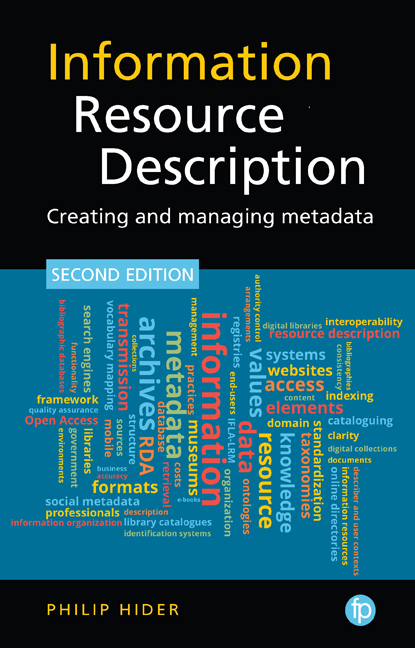Book contents
- Frontmatter
- Dedication
- Contents
- List of figures and tables
- Preface to the First Edition
- Preface to the Second Edition
- List of abbreviations
- 1 Definitions and scope
- 2 Information resource attributes
- 3 Tools and systems
- 4 Metadata sources
- 5 Metadata quality
- 6 Sharing metadata
- 7 Metadata standards
- 8 Vocabularies
- 9 The future of metadata
- Further reading
- List of metadata standards
- Index
1 - Definitions and scope
Published online by Cambridge University Press: 24 September 2019
- Frontmatter
- Dedication
- Contents
- List of figures and tables
- Preface to the First Edition
- Preface to the Second Edition
- List of abbreviations
- 1 Definitions and scope
- 2 Information resource attributes
- 3 Tools and systems
- 4 Metadata sources
- 5 Metadata quality
- 6 Sharing metadata
- 7 Metadata standards
- 8 Vocabularies
- 9 The future of metadata
- Further reading
- List of metadata standards
- Index
Summary
This chapter defines the book's scope and aims, and introduces key concepts that will be discussed at much greater length in the following chapters. The book's title and subtitle are explained first, and then how information resource description fits into the modern information environment. This is followed by an outline of the field of information organization and an overview of the book's structure.
Information resources
This book is about the description of information resources. Just about all types of resource can be described, and are. However, this book focuses on information resources. We are not so much interested in how vacuum cleaners, for instance, are described, as for the most part they are not used for their information value, but rather as a cleaning resource. On the other hand, if they are being used for information purposes, for example, if they are part of a museum exhibition on the development of domestic appliances, then their description, in that context, would be relevant. Nevertheless, the sorts of things that we will typically be dealing with in this book are those that have been created primarily for information purposes, such as books, e-books, websites, newspapers, videos, digital images and so on.
The word ‘primarily’ in that last sentence is worth repeating. A very sophisticated vacuum cleaner could, say, inform its user when the dust bag is full, but this would be a secondary function, supporting its primary function as a cleaning tool. As a museum object, however, a vacuum cleaner's primary function would indeed be to inform. Conversely, many resources found in museums, libraries, archives and other agencies that collect and manage information resources may do more than inform, even in these contexts. For instance, many library books are read for entertainment as much as for information, but we shall consider that, in general, the provision of information, in a broad sense, is still one of their primary functions, rather than merely a secondary function supporting the reader's entertainment.
Resources such as books have been providing information for a very long time. Created as information resources, they are thereby communication devices, designed to disseminate messages. Not all communication devices are information resources, however.
- Type
- Chapter
- Information
- Information Resource DescriptionCreating and Managing Metadata, pp. 1 - 22Publisher: FacetPrint publication year: 2018



